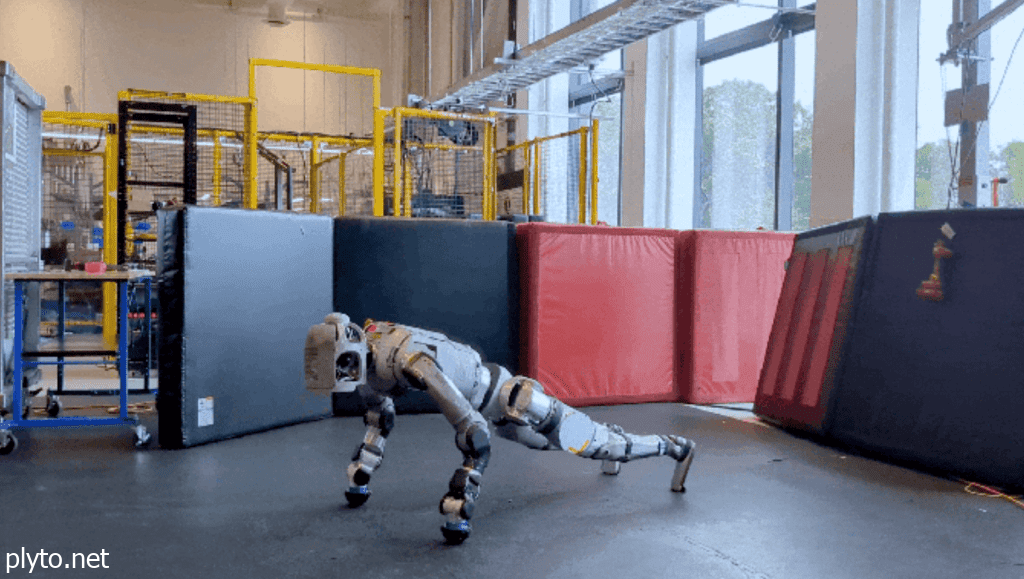In a landmark collaboration, Boston Dynamics and the Toyota Research Institute (TRI) have announced a groundbreaking partnership aimed at pushing the boundaries of humanoid robotics. Leveraging Boston Dynamics’ innovative Atlas robot and TRI’s cutting-edge Large Behavior Models (LBMs), the partnership promises to make significant strides in developing general-purpose humanoid robots that could revolutionize both industrial applications and everyday life. This collaboration stands as a testament to the rapid advancement in artificial intelligence (AI) and machine learning technologies, with far-reaching implications for robotics and human-robot interaction.
In this article, we will explore how this collaboration unfolds, the unique capabilities of the Atlas robot, the role of TRI’s Large Behavior Models, and the broader impact on robotics.
The Vision Behind the Partnership
The partnership between Boston Dynamics and TRI comes at a pivotal time for the robotics industry. Both companies are at the forefront of AI and robotics research, with complementary expertise. Boston Dynamics is renowned for its work in developing highly mobile and agile robots, such as Spot and Stretch, while TRI is recognized for its cutting-edge research in AI, specifically in developing models for robot learning and dexterity.
According to Robert Playter, CEO of Boston Dynamics, the collaboration represents “two companies with a strong research-and-development foundation coming together to work on many complex challenges and build useful robots that solve real-world problems.” This alliance is a clear demonstration of how powerful partnerships between leaders in AI and robotics can accelerate innovation and open new avenues for creating general-purpose robots—robots that can handle a wide variety of tasks, from industrial automation to household chores.
Gill Pratt, Chief Scientist for Toyota and CEO of TRI, echoed this sentiment, stating that recent advances in AI and machine learning have “tremendous potential for advancing physical intelligence.” The opportunity to implement TRI’s AI technologies on Boston Dynamics’ hardware is seen as a game-changing step for both companies as they work to amplify human ability and improve the overall quality of life through robotics.
Atlas Robot: The Epitome of Physical Capability and Agility
Central to this partnership is Boston Dynamics’ Atlas robot, which represents one of the most advanced humanoid platforms in existence. Atlas has been designed for extreme mobility and dexterity, making it capable of handling complex tasks that were once only possible for humans. Originally unveiled in 2013, Atlas has undergone numerous updates, with its most recent iteration boasting an electric design, replacing its earlier hydraulic system. This upgrade not only enhances its strength and endurance but also makes it easier to control and teleoperate.
The robot’s physical capabilities are nothing short of astounding. With a bipedal structure, Atlas can run, jump, backflip, and even perform advanced acrobatic maneuvers. In a recent demonstration video, the robot was shown doing pushups—a simple but powerful illustration of its muscular strength. Atlas can also manipulate objects using its bimanual capabilities, opening doors, moving boxes, and even performing complex assembly tasks.


Beyond physical prowess, Atlas is also equipped with sophisticated software for task planning and manipulation, enabling it to interact with its environment in meaningful ways. This makes it an ideal platform for testing and developing the next generation of AI models for humanoid robots.
Large Behavior Models: Advancing Dexterity through AI
While Atlas represents the pinnacle of robotic hardware, the Large Behavior Models (LBMs) developed by TRI bring intelligence and decision-making capabilities to the table. LBMs, much like Large Language Models (LLMs) used in platforms like ChatGPT, are designed to help robots understand and interact with the world through data-driven learning. However, unlike LLMs that deal with text and language, LBMs focus on enabling robots to perform complex physical tasks, such as manipulating objects or navigating through dynamic environments.
TRI’s research into LBMs has already yielded impressive results. At a recent TechCrunch Disrupt conference, Gill Pratt showcased how TRI has been able to achieve 90% accuracy in getting robots to perform household tasks like flipping pancakes after only a few dozen training iterations. This level of efficiency represents a significant breakthrough in AI-based robotics training, which typically requires thousands or even millions of training examples.
The ability to rapidly train robots for dexterous tasks using LBMs will be a game-changer for Atlas. By integrating TRI’s LBMs with Boston Dynamics’ Atlas robot, the joint research team aims to develop robots capable of acquiring new skills quickly and efficiently. This means that rather than requiring vast amounts of manual programming for each new task, robots like Atlas could learn on the fly, adapting to new environments and challenges as they arise.
Human-Robot Interaction and Safety Considerations
As robots become more integrated into human environments, the question of human-robot interaction and safety becomes increasingly important. The partnership between Boston Dynamics and TRI also focuses on addressing these key challenges. For humanoid robots to be deployed safely in homes, workplaces, and public spaces, they need to be able to interact with people in intuitive and non-threatening ways.
One of the key areas of research will be how robots like Atlas can leverage whole-body sensing to understand their surroundings and interact with humans safely. This involves developing AI models that can anticipate human actions and respond accordingly, such as recognizing when a person is in danger or needs assistance. In addition, Boston Dynamics and TRI will explore ways to ensure that robots adhere to strict safety protocols to prevent accidents or malfunctions.
Safety is especially crucial when dealing with general-purpose humanoid robots that may be deployed in diverse environments. The research teams will need to address questions around assurance measures, ensuring that robots can perform tasks reliably even in unpredictable or hazardous conditions.
The Broader Implications for Robotics
The partnership between Boston Dynamics and TRI represents a significant step forward in the development of general-purpose robots. As AI and machine learning continue to evolve, the potential applications for humanoid robots like Atlas are vast. From performing complex industrial tasks to assisting with daily household chores, robots that can think and act with the dexterity and intelligence of humans could transform multiple industries.
In the industrial sector, robots like Atlas could be used to automate dangerous or labor-intensive tasks, improving worker safety and productivity. In the healthcare industry, humanoid robots could assist with patient care, providing physical assistance and performing repetitive tasks, allowing healthcare professionals to focus on more specialized care.
Furthermore, the integration of LBMs into humanoid robots opens the door to more intuitive human-robot collaboration. Instead of having to manually program each task, users could simply instruct robots using natural language or visual cues, allowing for more seamless interaction between humans and machines.
Challenges and the Road Ahead
While the collaboration between Boston Dynamics and TRI holds immense promise, there are still many challenges to overcome. Artificial General Intelligence (AGI), the ability for robots to learn and perform any task a human can, remains a distant goal. While LBMs and Atlas’ hardware bring us closer to this reality, much work remains to be done in areas like robotic autonomy, safety, and reliability.
Nevertheless, the partnership marks an exciting moment for the robotics industry. By combining Boston Dynamics’ physical capabilities with TRI’s expertise in AI and machine learning, the two companies are poised to make significant advancements in the development of robots that can truly augment human ability and improve our quality of life.
As Robert Playter aptly noted, “There has never been a more exciting time for the robotics industry.” With this partnership, Boston Dynamics and TRI are leading the charge into a new era of humanoid robotics, where machines are not just tools but collaborators in solving some of the world’s most pressing challenges.
Conclusion
The partnership between Boston Dynamics and the Toyota Research Institute has the potential to revolutionize the future of robotics, with the Atlas robot playing a central role. As we move closer to developing general-purpose humanoid robots, the combined efforts of these two industry leaders will likely set the stage for new breakthroughs in AI, robotics, and human-robot interaction. Through this collaboration, we are witnessing the birth of machines that are not only physically capable but also intelligent enough to adapt to the ever-changing demands of our world. The future of robotics has never been brighter.
















